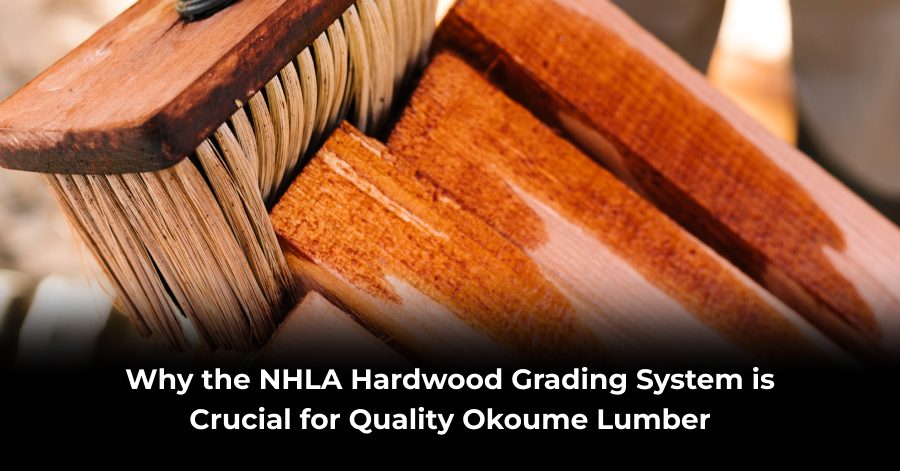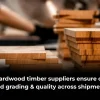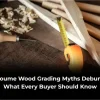For woodworkers, boatbuilders, and dedicated DIY enthusiasts, the journey from a project plan to a finished masterpiece is filled with critical choices. The most important of these is selecting the right materials. The beauty, strength, and very success of your creation depend on the quality of the wood you choose. This is where many, especially those new to the craft, can feel lost. Walking into a woodworking supplies store and being confronted with stacks of lumber labeled with cryptic acronyms like FAS, 1C, or Select can be overwhelming.
But what if you had a universal translator? A reliable, century-old code that demystifies quality and ensures you get exactly what you pay for? That’s the precise role of the NHLA hardwood grading system. For a specific and beloved species like Okoume, understanding this system isn’t just helpful—it’s absolutely crucial. Let’s dive into why this standard is the unsung hero of quality woodworking and how it directly impacts your work with Okoume marine plywood and lumber.
The NHLA: Establishing a Common Language for Quality and Trust
Founded in 1898, the National Hardwood Lumber Association (NHLA) established its grading system to create a fair and consistent trading language for the American hardwood industry. Think of it less as a set of rigid rules and more as a promise. It’s a promise from the mill to the woodworking supplies store, and from the store to you, the customer, that the board you’re buying meets a specific, agreed-upon standard of quality. This system removes guesswork and builds trust across the entire supply chain, ensuring that a “FAS” grade in one part of the country means the same thing in another.
The system is brilliantly practical, based on the principle of yield—the percentage of clear, defect-free wood in a board that can be cut into smaller pieces. NHLA graders are highly trained experts who can assess a board in seconds, visually calculating the size and number of clear “cuttings” that can be obtained from it. This focus on usable material makes the NHLA hardwood grading system an indispensable tool for woodworkers who need to maximize their material investment and minimize costly waste.
Okoume: The Lightweight Champion of the Workshop and the Water
Before we connect the grading to the wood, it’s essential to appreciate Okoume itself (Aucoumea klaineana). Native to the lush forests of West Africa, this species has earned a stellar reputation for its unique combination of properties. It’s remarkably lightweight—often compared to Mahogany but significantly less dense—making it the ideal choice for applications where weight is a primary concern, such as boat building, furniture, and intricate millwork. Its grain is typically straight and fine with a uniform texture, sporting a beautiful pale pink to light reddish-brown hue that accepts stains and finishes exceptionally well.
However, its most celebrated application is in the marine world. When laminated into plywood, Okoume becomes the gold standard for Okoume marine plywood. Its thin veneers are bonded with permanent, waterproof adhesives, creating a panel that is incredibly strong for its weight, dimensionally stable, and highly resistant to delamination. But the quality of that premium panel starts with the quality of the veneers used to make it—and that’s where the NHLA hardwood grading system comes into play, ensuring only the best faces and cores are selected.
Decoding the Grades: A Practical Guide for Your Projects
You don’t need to become a certified grader, but understanding the basic grades will fundamentally change how you shop for materials. When you browse a woodworking supplies store, either in-person or online, you’ll typically encounter these primary NHLA grades for hardwoods like Okoume:
- FAS (First and Second): This is the highest grade available. FAS boards are long and wide and must yield a minimum of 83-1/3% clear defect-free wood on both faces. If your project requires large, uninterrupted surfaces for a stunning table top, elegant cabinet sides, or the face veneers on high-quality Okoume marine plywood, this is the grade you want. You’re paying a premium for size, clarity, and the highest yield.
- Select: This grade offers a “show face” that is virtually identical to FAS, but it allows for more defects on the reverse side. It’s perfectly suited for projects where only one face will be visible, like a shelving unit, a desk top against a wall, or the back of a cabinet. It provides a high-quality appearance at a slightly more accessible price point than FAS.
- No. 1 Common: Often affectionately called “Cabinet Grade,” this is where outstanding value meets practicality. The yield requirement is lower (66-2/3%), meaning you will find more knots, mineral streaks, or other natural character marks. For many woodworkers, this is the sweet spot. The defects are usually sound (think tight knots, not loose ones) and can add unique character and warmth to a project. It’s also excellent for cutting into smaller pieces, minimizing waste, and is often used for the inner plies of plywood.
Seeing wood grade images alongside these descriptions is one of the best ways to solidify your understanding. A quick online search for “NHLA wood grade images” will provide visual examples that make these textual definitions crystal clear and help you train your eye.
The Invisible Backbone: How Grading Guarantees Superior Marine Plywood
This is where the theoretical knowledge of the NHLA hardwood grading system meets tangible, real-world quality. Okoume marine plywood is an engineered product constructed from multiple layered veneers. The core and inner piles might utilize a sound but lower grade (like No. 1 Common) because their primary role is to provide structural integrity, and their appearance isn’t critical. However, the face veneers are everything you see and touch; they define the panel’s aesthetic and surface quality.
A reputable and trustworthy manufacturer will insist on using FAS or Select-grade veneers for the faces of their premium Okoume marine plywood. This diligent adherence to grading ensures:
- A Flawless Finish: The surface is smooth and continuous, free of large knots or ugly patches, allowing for a beautiful clear coat, paint, or varnish without unsightly blemishes telegraphing through your finish.
- Structural Consistency: While beauty is critical, a high-grade face also indicates a veneer that is less likely to have hidden weaknesses, splits, or flaws that could compromise the panel’s surface integrity over time.
- Predictable Workability: You can plan your cuts, joins, and finishing techniques knowing the surface won’t be interrupted by a large defect right where you need a perfectly clean edge.
Without the strict guidelines of the NHLA hardwood grading system, you’d essentially be buying mystery plywood. The label “marine” might truthfully speak to the type of adhesive used, but the grade speaks directly to the quality of the wood itself. Trusting a supplier who deeply understands and respects this grading is paramount to your project’s success.
Beyond the Lumber Rack: The Value of a Knowledgeable Supplier
Choosing the right grade is a skillful balancing act between budget, project requirements, and desired aesthetics. A high-end furniture maker crafting a heirloom table will have different needs than a boatbuilder laminating a curved hull frame. This is why partnering with a knowledgeable and well-stocked woodworking supplies store is so invaluable.
The right store does more than just sell you wood; they act as a resource and partner in your creativity. They can help you interpret the NHLA hardwood grading system, show you actual wood grade images from their current stock, and offer expert advice on whether you need FAS for a showpiece door or if No. 1 Common is perfectly suited for your built-in shelves. When it comes to specialized products like Okoume marine plywood, their expertise is indispensable in ensuring you get a product that truly is marine-grade in both name and quality.
About AEW Woods: Your Partner in Premium Quality
When seeking a supplier that embodies this deep commitment to quality, expertise, and customer service, look no further than AEW Woods. AEW Woods has established itself as a premier supplier specializing in high-quality, sustainably sourced hardwood lumber and sheet goods, including exceptional Okoume marine plywood. Their team is deeply knowledgeable about the NHLA hardwood grading system and takes pride in ensuring every piece they sell is accurately graded and of the highest caliber. For woodworkers, craftsmen, and builders who refuse to compromise on quality, AEW Woods is more than a vendor; they are a trusted partner, providing not just superior materials, but the confidence that comes with them.
Also Read – Okoume Wood Grade Images: A Visual Comparison Guide [2025]
Conclusion: Build with Confidence, Build with Knowledge
In the world of woodworking, knowledge is power and is just as important as skill. Understanding the NHLA hardwood grading system empowers you to make informed decisions, manage your budget effectively, and ultimately achieve superior, predictable results in all your projects. It transforms a trip to the woodworking supplies store from a guessing game into a targeted mission for quality.
For a material as versatile and prized as Okoume, especially when used in critical applications like Okoume marine plywood, this grading system is the undeniable bedrock of quality. It ensures that the beautiful, lightweight, and strong wood you’ve selected performs and looks exactly as you envisioned. So, the next time you’re sourcing materials, listen to the language of the grades. It’s a conversation about quality, and thanks to the NHLA, we can all understand it perfectly. And for a supplier that speaks this language fluently, consider a trusted partner like AEW Woods for all your hardwood needs.
Frequently Asked Questions (FAQs)
- Can I use a lower grade of Okoume for hidden structural parts?
Yes. Use lower, sound grades like No. 1 Common for internal frames and structures, saving high-grade FAS for visible surfaces. - Where can I find clear NHLA wood grade images?
The NHLA website is the best source. Many reputable woodworking stores and blogs also provide helpful wood grade images. - Does the NHLA system apply to plywood?
The system grades rough lumber. However, the veneers used in high-quality Okoume marine plywood are selected using NHLA standards. - Is all “Marine” plywood made with high-grade faces?
No. “Marine” refers to the adhesive. Always verify the face veneer grade with your supplier. - Why is there a price difference between FAS and No. 1 Common?
FAS offers a higher yield of clear, wide cuttings, making it more scarce and valuable than the more character-rich No. 1 Common.






